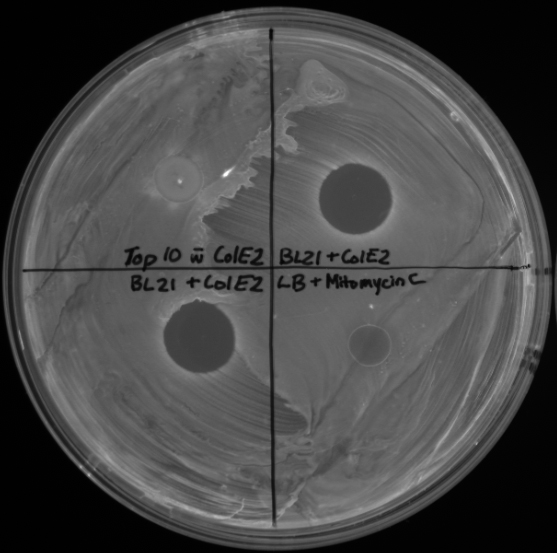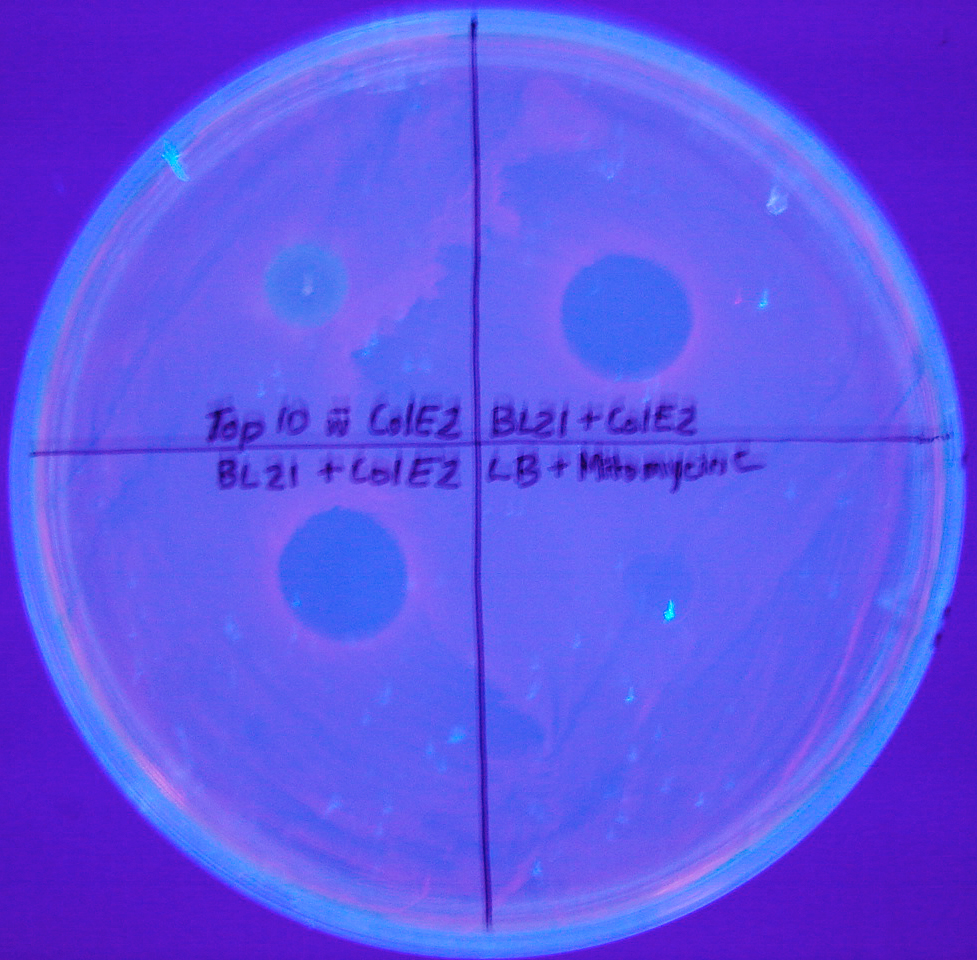Difference between revisions of "Part:BBa K131000"
KevinMcLeod (Talk | contribs) |
|||
| (6 intermediate revisions by the same user not shown) | |||
| Line 5: | Line 5: | ||
===Usage and Biology=== | ===Usage and Biology=== | ||
| − | A colicin is an antibiotic protein produced by some E coli strains that is active against other E coli not possessing the plasmid (which contains an immunity gene). Colicin E2 is a DNAse, which enters the cell through the BtuB receptor. | + | A colicin is an antibiotic protein produced by some ''E. coli'' strains that is active against other ''E. coli'' not possessing the plasmid (which contains an immunity gene). Colicin E2 is a DNAse, which enters the cell through the BtuB receptor. |
| − | This operon is under the control of the | + | This operon is under the control of the SOS promoter from ''E. coli'' and is repressed under normal conditions. This promoter is activated upon DNA damage by the SOS response, which can be initiated in the lab by the addition of some dilute antibiotics, such as mitomycin C. When active, the promoter allows expression of both the colicin itself (<bbpart>K131004</bbpart>) and the immunity gene (<bbpart>K131003</bbpart>). After the immunity gene there is a terminator, followed directly by the lysis gene (<bbpart>K131005</bbpart>). Because of this, the lysis gene is only expressed when RNA polymerase is able to traverse the terminator, leading to very, very low levels of production even when the SOS promoter is fully active. This gene is responsible for lysing the cell once it has produced large quantities of colicin, allowing the colicin out. As a note, even though this system requires the cell to commit suicide, it is still relatively efficient because it can take as little as one of the released colicins to kill another cell. |
| − | This operon is available without the | + | This operon is available without the SOS promoter (<bbpart>K131009</bbpart>), which is used as one of the response circuits in the University of Calgary 2008's champion cell (<bbpart>K131010</bbpart>). |
<!-- --> | <!-- --> | ||
| Line 20: | Line 20: | ||
<partinfo>BBa_K131000 parameters</partinfo> | <partinfo>BBa_K131000 parameters</partinfo> | ||
<!-- --> | <!-- --> | ||
| + | |||
| + | ==Pictures== | ||
| + | <gallery> | ||
| + | Image:ColE2BW.jpg|Colicin E2 expressed in BL21 spotted on RFP ''E. coli'' under white light. | ||
| + | Image:ColE2RFP.jpg|Colicin E2 expressed in BL21 spotted on RFP ''E. coli'' under UV light. | ||
| + | Image:ColE2mC.jpg|Another functional test. | ||
| + | </gallery> | ||
| + | |||
| + | ==Characterization of Colicin E2== | ||
| + | Details of inducing colicin can be found under [https://parts.igem.org/Part:BBa%20K131000:Design Part Design]. Explore the University of Calgary's 2008 [http://2008.igem.org/Team:Calgary_Wetware wiki] to see how it was used. | ||
| + | |||
| + | {|border=1 width="90%" align="center" | ||
| + | |- | ||
| + | !width="20%" style="background:#CCCCFF"|Parameter | ||
| + | !width="80%"|Value and Description | ||
| + | |-align="center" | ||
| + | |style="background:#EEEEFF"|Optimal Temperature | ||
| + | |37°C | ||
| + | |-align="center" | ||
| + | |style="background:#EEEEFF"|Required Bacteria | ||
| + | |RecA Positive ''E. coli'', such as BL21 | ||
| + | |-align="center" | ||
| + | |style="background:#EEEEFF"|Optimal Mitomycin C Concentration | ||
| + | |Works with 1µg/mL final concentration. In a 5 mL culture, this would be 10µL of 0.5mg/mL mitomycin C. | ||
| + | |-align="center" | ||
| + | |style="background:#EEEEFF"|Optimal Mitomycin C Induction Time | ||
| + | |2-4 hours before spotting. | ||
| + | |-align="center" | ||
| + | |style="background:#EEEEFF"|Lawn Characteristics | ||
| + | |100µL of OD=0.3-0.5 (at 600nm, exponential phase), freshly plated. | ||
| + | |-align="center" | ||
| + | |style="background:#EEEEFF"|Spotted Culture | ||
| + | |Supernatant (as Colicin E2 is excreted) or resuspended cells, washed with LB (to remove mitomycin C) work equally well. | ||
| + | |||
| + | |} | ||
Latest revision as of 01:02, 30 October 2008
ColE2 Operon
This part contains the ColE2 operon in its entirety.
Usage and Biology
A colicin is an antibiotic protein produced by some E. coli strains that is active against other E. coli not possessing the plasmid (which contains an immunity gene). Colicin E2 is a DNAse, which enters the cell through the BtuB receptor.
This operon is under the control of the SOS promoter from E. coli and is repressed under normal conditions. This promoter is activated upon DNA damage by the SOS response, which can be initiated in the lab by the addition of some dilute antibiotics, such as mitomycin C. When active, the promoter allows expression of both the colicin itself (K131004) and the immunity gene (K131003). After the immunity gene there is a terminator, followed directly by the lysis gene (K131005). Because of this, the lysis gene is only expressed when RNA polymerase is able to traverse the terminator, leading to very, very low levels of production even when the SOS promoter is fully active. This gene is responsible for lysing the cell once it has produced large quantities of colicin, allowing the colicin out. As a note, even though this system requires the cell to commit suicide, it is still relatively efficient because it can take as little as one of the released colicins to kill another cell.
This operon is available without the SOS promoter (K131009), which is used as one of the response circuits in the University of Calgary 2008's champion cell (K131010).
Sequence and Features
- 10COMPATIBLE WITH RFC[10]
- 12COMPATIBLE WITH RFC[12]
- 21INCOMPATIBLE WITH RFC[21]Illegal BglII site found at 2228
- 23COMPATIBLE WITH RFC[23]
- 25COMPATIBLE WITH RFC[25]
- 1000COMPATIBLE WITH RFC[1000]
Pictures
Characterization of Colicin E2
Details of inducing colicin can be found under Part Design. Explore the University of Calgary's 2008 [http://2008.igem.org/Team:Calgary_Wetware wiki] to see how it was used.
| Parameter | Value and Description |
|---|---|
| Optimal Temperature | 37°C |
| Required Bacteria | RecA Positive E. coli, such as BL21 |
| Optimal Mitomycin C Concentration | Works with 1µg/mL final concentration. In a 5 mL culture, this would be 10µL of 0.5mg/mL mitomycin C. |
| Optimal Mitomycin C Induction Time | 2-4 hours before spotting. |
| Lawn Characteristics | 100µL of OD=0.3-0.5 (at 600nm, exponential phase), freshly plated. |
| Spotted Culture | Supernatant (as Colicin E2 is excreted) or resuspended cells, washed with LB (to remove mitomycin C) work equally well. |



